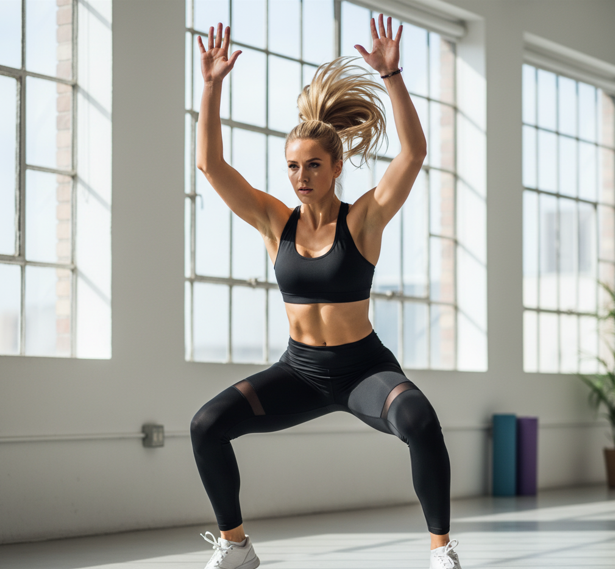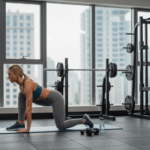Take your squats to new heights! Jump squats combine strength and cardio in one explosive movement, targeting your legs, glutes stretches, and core while boosting power and flexibility.
🔍 What Jump Squats Target
Jump squats exercise focuses on developing explosive power in your quadriceps, glutes, and calves while improving cardiovascular endurance and lower body flexibility. Think of it as a regular squat’s energetic cousin that builds athleticism!
✨ Key Benefits of Jump Squats
✅ Builds explosive power for sports and daily activities
✅ Torches calories with high-intensity cardiovascular benefits
✅ Improves lower body flexibility and range of motion
✅ Enhances bone density through impact training
✅ Boosts metabolic rate long after your workout ends
🏋️ How To Do Jump Squats Exercise
1️⃣ Starting Position
- Stand with feet shoulder-width apart, toes pointed slightly out
- Keep chest up, shoulders back, and core engaged
- Arms can be at the sides or in the “ready” position
2️⃣ The Descent
- Lower into a squat position, pushing hips back
- Keep knees aligned with toes, back straight
- Descend until thighs are parallel to the floor (or comfortable depth)
3️⃣ The Explosion
- Drive powerfully through your heels
- Explode upward, extending hips, knees, and ankles
- Swing arms upward for momentum
4️⃣ The Landing
- Land softly on the balls of your feet, rolling to your heels
- Bend knees to absorb impact immediately
- Return directly to squat position for next rep
Modifications:
- Beginner: Jump squats, alternative Squat jumps (less height) or step-back lunges
- Advanced: Add tuck jump or increase repetition speed
FAQs🔥
Q: Are jump squats better than regular squats for weight loss?
A: Jump squats torch more calories per minute due to their high-intensity nature, making them excellent for fat loss. However, regular squats allow heavier loading for muscle building. Combine both for the best results!
Q: Can beginners do jump squats safely?
A: Yes, but start with squat jumps (minimal air time) and focus on perfect landing form. Build base strength with regular squats first, and always warm up properly.
Q: How many jump squats should I do per day?
A: Start with 3-4 sets of 8-10 reps, 2-3 times weekly. Quality over quantity – focus on explosive power and controlled landings rather than high reps.
Q: Do jump squats build bigger legs?
A: They build powerful, athletic legs rather than bulky muscles. For size, combine them with heavy squats. For definition and power, jump squats are perfect!
Q: What’s the best jump squats alternative for bad knees?
A: Try box squats or resistance band squats instead. These reduce impact while still building lower-body strength. Always consult a doctor for knee issues.
Q: Can I do jump squats every day?
A: Not recommended, your joints need recovery time. Limit to 3-4 times weekly max, and listen to your body. Active recovery days are crucial!
⚠️ Safety Tips & Common Mistakes
🚫 Don’ts
✖ Land with straight legs (always bend knees!)
✖ Let knees collapse inward (keep them aligned!)
✖ Round your back during descent (maintain neutral spine!)
✅ Do’s
✔ Warm up thoroughly with dynamic stretches
✔ Focus on soft, controlled landings
✔ Start with low reps and build gradually
✔ Use proper footwear with good cushioning
🌟 Pro Tip
Incorporate jump squats into your routine 2-3 times weekly, and consider them as a jump squats alternative to regular squats when you want to add cardio benefits to your strength training!








